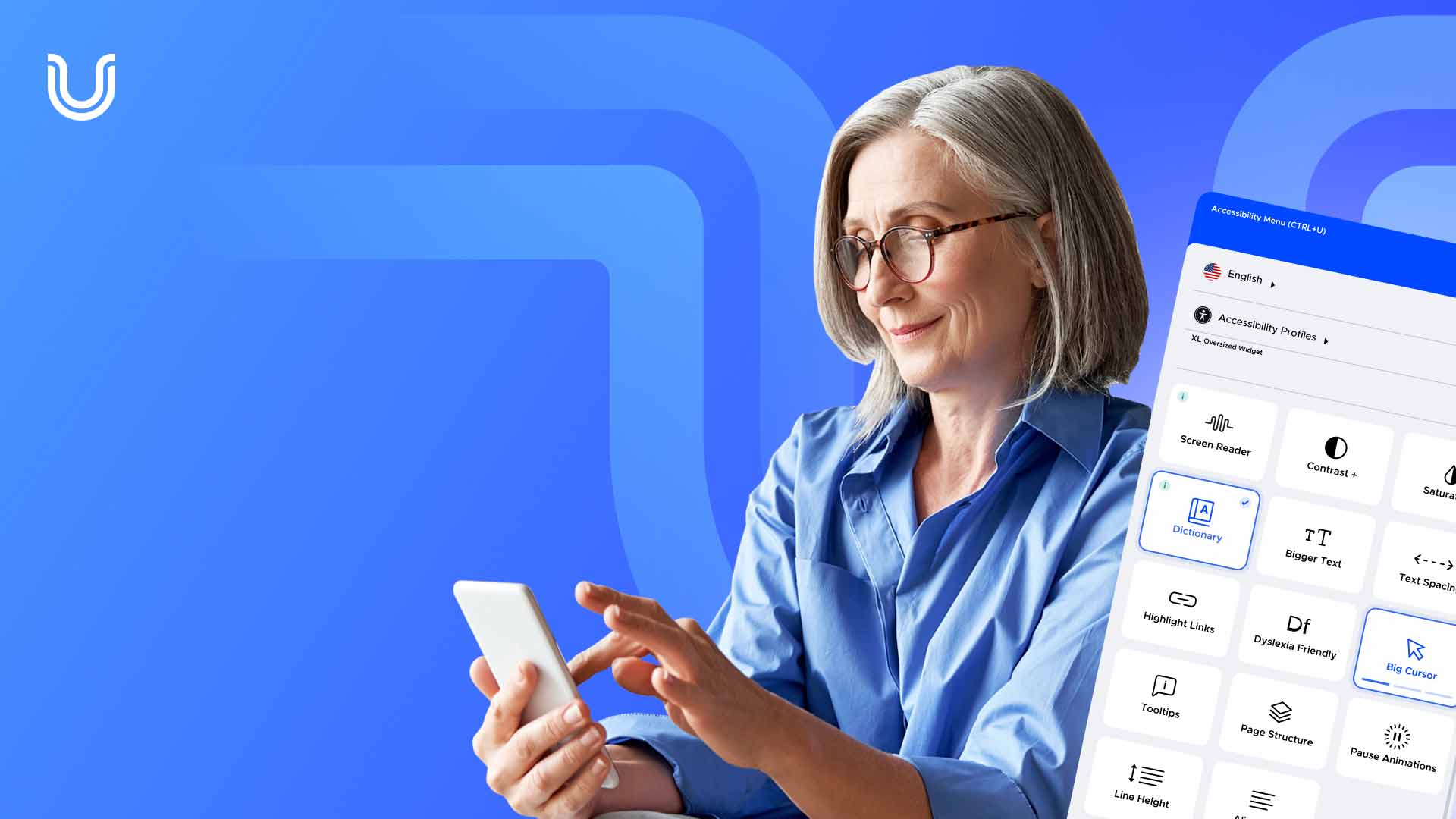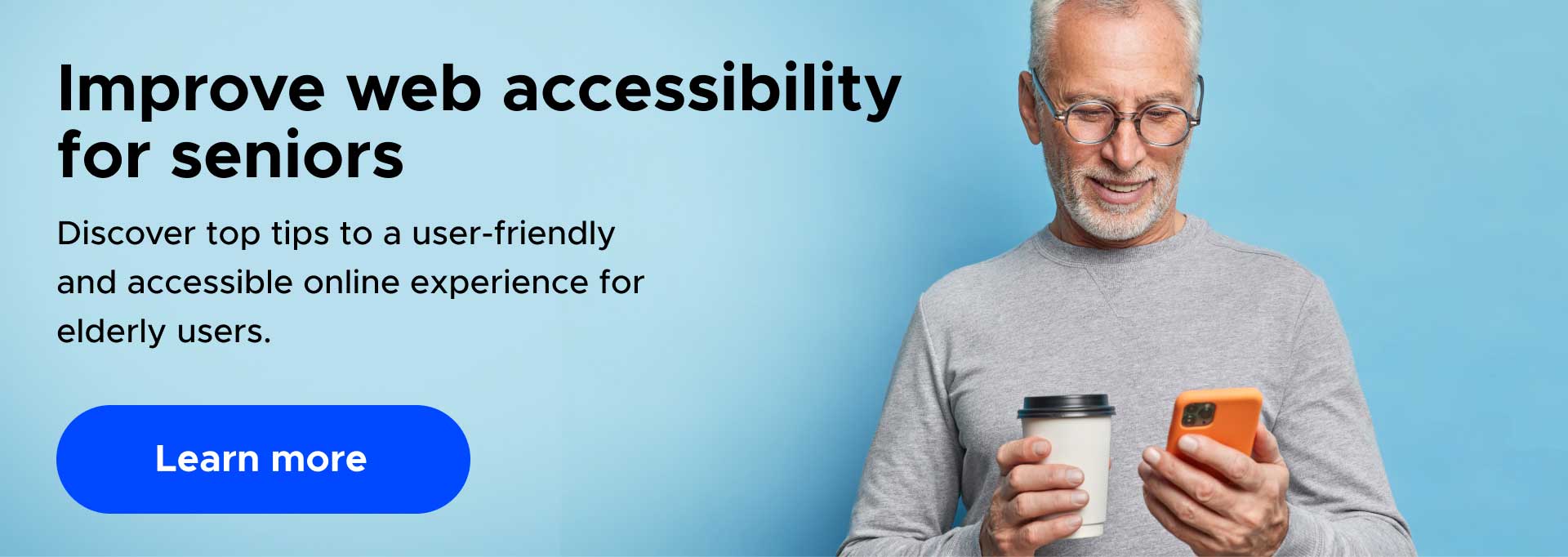Ensuring digital accessibility for older people

As our population rapidly ages, catering to the digital needs of older people becomes increasingly vital. Digital accessibility takes center stage as society progressively demands a web where everyone can fully participate and benefit, regardless of age or ability.
Nearly everybody relies on websites and digital devices for personal and business reasons. That said, mobile responsiveness and sleek user interfaces alone don’t accommodate many user needs, including those of senior citizens. Organizations of every kind should strive to remove online barriers and enhance digital accessibility for this critical demographic.
This blog explores real-world challenges and solutions for better accommodating older users. Let’s start by looking at age-related conditions that can hinder their user experience
How does age impact web usage for older people?
Below, we look at age-related conditions that create unique challenges for older adults.
- Vision: diminished contrast sensitivity, color perception, and near-focus abilities hinder web page readability and navigation.
- Physical: decreased agility and fine motor skills make using a mouse and clicking small navigation elements difficult.
- Hearing: older end users may need help to discern and separate high-pitched sounds. This challenge can interrupt audio experiences like podcasts, particularly those with background music.
- Cognitive: declines in short-term memory, concentration, and focus make navigation more complicated for older users.
What website elements are problematic for senior citizens?
Small Text Sizes
Eyesight deteriorates with age, making it challenging to read tiny fonts. Imagine an older person trying to read an article on a news website with minuscule, crowded text. Barriers like this can frustrate these users and deter them from engaging with digital content.
Low Contrast
Many websites use subtle color schemes or light text on a light background, which is particularly problematic for older users with reduced contrast sensitivity. The lack of contrast makes distinguishing between text and background elements challenging, resulting in eye strain and comprehension issues.
Complex Navigation
Navigating intricate menus and nested links can confuse and overwhelm those with limited tech experience. Picture an older adult trying to complete an online purchase but needing help navigating multiple steps and dropdown menus. These hurdles discourage repeat visitation and can damage your website’s reputation.
What are real-world examples that older people experience?
Fine motor skills tend to diminish with age, making it challenging for older adults to perform precise actions like clicking small buttons or typing accurately on a touchscreen device.
To better understand the impact of these barriers, let’s consider some real-life examples:
-
- Example 1: Jane’s Online Shopping Experience: Jane, a senior citizen, purchases a gift for her grandchild from an online store. But she needs help with the site’s small text and low contrast, which make browsing product descriptions and prices too hard. Plus, she needs clarification on the complex navigation system, which leads her to abandon her shopping cart.
- Example 1: Jane’s Online Shopping Experience: Jane, a senior citizen, purchases a gift for her grandchild from an online store. But she needs help with the site’s small text and low contrast, which make browsing product descriptions and prices too hard. Plus, she needs clarification on the complex navigation system, which leads her to abandon her shopping cart.
-
- Example 2: John’s Social Media Struggles
As an older adult, John wants to stay connected with his family through social media. However, he finds it challenging to use the platform’s small icons and buttons, discouraging him from navigating and interacting with posts. As a result, he feels isolated and excluded from essential family updates and events.
- Example 2: John’s Social Media Struggles
-
- Example 3: Jenine’s Pharmacy Website Challenges
Jenine is an older user on a regimented routine with critical medications for her glaucoma. She also has age-related mobility issues that make it difficult for her to drive. Her online pharmacy doesn’t provide screen-reader technology, which makes it hard for her to refill her meds for delivery. What if there’s nobody around to help her with the website or drive her to the pharmacy?
- Example 3: Jenine’s Pharmacy Website Challenges
Now, let’s move on to actionable online solutions for senior citizens.
How can we improve digital accessibility for older users?
Websites should be equally inclusive and enjoyable for all end users. Here are some strategies to enhance accessibility for older people:
1. Implement Adjustable Text Sizes
Allow users to adjust text sizes so they can read content comfortably without straining their eyes. Providing larger fonts also improves inclusivity for users with varying visual abilities.
2. Use Proper Color Contrast
Provide recommended color contrast between foreground text and background imagery to improve readability for older users. For the best results, follow WC3 requirements.
3. Simplify Navigation
Minimize the required mouse clicks to access desired features and content. Use clear labels and user-friendly menus to prevent cognitive overload.
4. Offer Touch-friendly Design
Incorporate larger targets and spacing elements for users with diminished fine motor skills. Enlarging navigation elements with screen magnifiers enables older users to navigate touchscreen devices more comfortably and accurately.
5. Provide Alternative Inputs
Offer alternative input methods, such as voice commands or keyboard shortcuts. These options empower people with mobility or dexterity impairments to navigate digital interfaces.
6. Use Enough White Space
Provide plenty of space between lines and blocks of text to help users track text horizontally and read and comprehend content more easily.
7. Add Form Field Labels
Add form fields at the code level so screen readers can distinguish them for labels and prompts. Follow related best practices to ensure you get it right.
8. Use Text Instead of Text Images
Text images blur when magnified and cause slower download speeds when enlarged. It’s also better for SEO to use text with relevant keywords whenever possible.
9. Use Proper Headings
Use headings and subheadings to outline pages. Don’t skip heading levels because they help screen reader users and search engines better understand page organization.
10. Use a JavaScript Accessibility Widget
Using an existing accessibility widget streamlines production and ensures better accuracy. On the other hand, the in-house approach is cost-prohibitive, a drain on resources, and considerably more challenging to maintain accurately.
Why is catering to older users good for business?
Why should your website accommodate older people? Beyond the obvious ethical reasons, senior citizens have substantial disposable income. Consider this: older adults account for over 50 percent of U.S. consumer spending, but just 5–10 percent of marketing budgets focus on winning their business.1 Younger demographics may be among the most followed social influencers, but their older counterparts have the edge on financial and economic influence.
- AARP projects massive spending upticks for 50+ consumers between 2018 and 2050:
-
- Over 190% growth in financial & insurance services
-
- Over 340% increase in the technology sector
-
- Over 230% surge in travel and leisure
-
- Over 260% increase in the healthcare sector
- Gen Z has 86% less purchasing power than Baby Boomers did in their 20s
Better accessibility for older people is better for us all
Estimates show that the over-sixty population will double to over two billion by 2050 and triple to over three billion by 2100. 4 This is the fastest-growing demographic, and its members rely on the web and have significant buying power. That’s why it’s never been more critical to improve accessibility for older users.
Better accessibility also creates a better user experience for all customers, regardless of ability or background. So, embracing digital inclusivity also provides distinct business advantages. By addressing specific barriers such as small text sizes, low contrast, complex navigation, and reliance on fine motor skills, we can create a more inclusive online experience for our senior citizens.
UserWay: A better path forward for all end users
UserWay’s accessibility solutions are for people of all ages, backgrounds, and abilities. Learn why companies worldwide choose UserWay’s AI-powered accessibility tools, monitoring, legal support services, and enterprise solutions for their inclusivity and compliance needs.
Answers to common FAQs
Why is digital accessibility essential for older adults?
Digital accessibility is essential for older adults for the same reasons anyone needs it. The web is the go-to choice for people worldwide, from work to entertainment to medical needs and travel.
What age-related impacts make tech difficult for older people?
Visual degeneration, hearing loss, motor skill decline, and cognitive loss can pose unique obstacles for older users on the web. These barriers can make learning and using new technologies difficult, as they often require the ability to see and hear clearly.
Can older users learn the latest tech?
Some seniors may feel behind the tech curve, but most are willing and fast learners. After all, many of our older people helped forge the technology that inspired others to propel us into the digital age. Using an accessible website is well within their capabilities.





Share